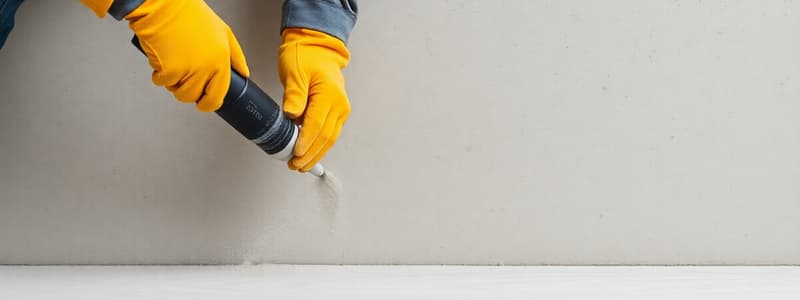Podcast
Questions and Answers
What is the primary purpose of using a broom finish on concrete surfaces?
What is the primary purpose of using a broom finish on concrete surfaces?
- To minimize wear and tear on industrial flooring
- To improve slip resistance in wet conditions (correct)
- To expedite the curing process of concrete
- To enhance aesthetic appeal with a smooth surface
How long does the curing process for concrete typically take?
How long does the curing process for concrete typically take?
- Only the first day after pouring is critical
- Days and weeks following the initial pour (correct)
- Instantly solidifying upon pouring
- A few hours until it hardens completely
Which of the following statements about bar diameters is correct?
Which of the following statements about bar diameters is correct?
- Standard bar sizes usually fall between N12 and N36 (correct)
- Standard bars typically range from 5mm to 50mm in diameter
- Larger bar sizes are more common than smaller ones
- Bars supplied to a site come only in sizes N10 to N100
What is the main characteristic of mesh used in concrete work?
What is the main characteristic of mesh used in concrete work?
What does burnishing concrete involve?
What does burnishing concrete involve?
What is the maximum free fall height for concrete before alternative methods should be used?
What is the maximum free fall height for concrete before alternative methods should be used?
Which method is typically used to avoid segregation of concrete?
Which method is typically used to avoid segregation of concrete?
What is the purpose of the compaction process in concrete pouring?
What is the purpose of the compaction process in concrete pouring?
What feature helps ensure that a concrete slab is flat after pouring?
What feature helps ensure that a concrete slab is flat after pouring?
What is the effect of improper mixing on concrete?
What is the effect of improper mixing on concrete?
Which finishing technique is most appropriate for a slab intended to be tiled?
Which finishing technique is most appropriate for a slab intended to be tiled?
During which stage of concrete work is a vibrator typically used?
During which stage of concrete work is a vibrator typically used?
What is considered a negative effect of concrete segregation?
What is considered a negative effect of concrete segregation?
What is the value of $k_1$ for bars that have more than 300 mm of concrete cast below them?
What is the value of $k_1$ for bars that have more than 300 mm of concrete cast below them?
What is the range of value for $k_3$ according to the given conditions?
What is the range of value for $k_3$ according to the given conditions?
What does the smaller of the concrete cover to the bar or half the clear distance to the next parallel bar represent?
What does the smaller of the concrete cover to the bar or half the clear distance to the next parallel bar represent?
How is $k_4$ affected when transverse reinforcement is provided in the cover side closer to the surface?
How is $k_4$ affected when transverse reinforcement is provided in the cover side closer to the surface?
What does $K$ equal if the transverse steel is provided on the inner side and is ineffective?
What does $K$ equal if the transverse steel is provided on the inner side and is ineffective?
What is the primary purpose of deformed steel bars in concrete?
What is the primary purpose of deformed steel bars in concrete?
Which type of reinforcement is most commonly used?
Which type of reinforcement is most commonly used?
What does the term 'cover' refer to in the context of placing reinforcement?
What does the term 'cover' refer to in the context of placing reinforcement?
What is the role of 'chairs' when placing reinforcement?
What is the role of 'chairs' when placing reinforcement?
What distinguishes SL101 from SL72 in terms of specifications?
What distinguishes SL101 from SL72 in terms of specifications?
Which reinforcement type is primarily used in mesh applications?
Which reinforcement type is primarily used in mesh applications?
What exposure classification is designated for internal surfaces?
What exposure classification is designated for internal surfaces?
How is reinforcement fixed together during placement?
How is reinforcement fixed together during placement?
What is required to obtain the quantity of reinforcement within the joint?
What is required to obtain the quantity of reinforcement within the joint?
Where is the offset located in relation to the lap?
Where is the offset located in relation to the lap?
What problem does the cranked portion of beam steel create?
What problem does the cranked portion of beam steel create?
What does the spacing of column ties within the column height generally indicate?
What does the spacing of column ties within the column height generally indicate?
What provides a good solution to beam-column intersection problems, especially in narrow beams?
What provides a good solution to beam-column intersection problems, especially in narrow beams?
What is the minimum extension required for a simply supported slab if all reinforcement extends beyond the support?
What is the minimum extension required for a simply supported slab if all reinforcement extends beyond the support?
How much total positive moment reinforcement must extend past the near face of a support for continuous or restrained slabs?
How much total positive moment reinforcement must extend past the near face of a support for continuous or restrained slabs?
When dealing with a continuous slab and unequal shorter spans, how is the negative moment reinforcement extension determined?
When dealing with a continuous slab and unequal shorter spans, how is the negative moment reinforcement extension determined?
In the case of a two-way slab, what is the maximum length for negative moment reduction at a discontinuous edge?
In the case of a two-way slab, what is the maximum length for negative moment reduction at a discontinuous edge?
What is required if only half of the reinforcement requirement at mid-span extends beyond the face of the support?
What is required if only half of the reinforcement requirement at mid-span extends beyond the face of the support?
How must the arrangement of reinforcement be determined for two-way slabs?
How must the arrangement of reinforcement be determined for two-way slabs?
Which statement is true about shear reinforcement requirements in slabs?
Which statement is true about shear reinforcement requirements in slabs?
For a simply supported slab, how much of the reinforcement at the mid-span should extend beyond the face of the support if shear reinforcement is needed?
For a simply supported slab, how much of the reinforcement at the mid-span should extend beyond the face of the support if shear reinforcement is needed?
Flashcards
Burnished Finish
Burnished Finish
A concrete finish created by rotating a steel blade to create a shiny surface.
Broom Finish
Broom Finish
A rough concrete finish created using a broom to rake the surface.
Concrete Curing
Concrete Curing
The process of concrete changing from a soft to hard state over days/weeks.
Concrete Testing
Concrete Testing
Signup and view all the flashcards
Reinforcement Bar (Bar)
Reinforcement Bar (Bar)
Signup and view all the flashcards
Concrete segregation
Concrete segregation
Signup and view all the flashcards
Causes of segregation
Causes of segregation
Signup and view all the flashcards
Concrete compaction
Concrete compaction
Signup and view all the flashcards
Honeycombing
Honeycombing
Signup and view all the flashcards
Concrete finishing
Concrete finishing
Signup and view all the flashcards
Free fall limit (concrete)
Free fall limit (concrete)
Signup and view all the flashcards
Concrete pump method
Concrete pump method
Signup and view all the flashcards
Concrete float
Concrete float
Signup and view all the flashcards
What is reinforcement in concrete?
What is reinforcement in concrete?
Signup and view all the flashcards
Why are reinforcing bars deformed?
Why are reinforcing bars deformed?
Signup and view all the flashcards
What are the types of reinforcement ductility?
What are the types of reinforcement ductility?
Signup and view all the flashcards
Who places the reinforcement?
Who places the reinforcement?
Signup and view all the flashcards
What is 'cover' in concrete?
What is 'cover' in concrete?
Signup and view all the flashcards
How is reinforcement fixed together?
How is reinforcement fixed together?
Signup and view all the flashcards
What are 'chairs' in concrete?
What are 'chairs' in concrete?
Signup and view all the flashcards
What is AS3600?
What is AS3600?
Signup and view all the flashcards
Development Length
Development Length
Signup and view all the flashcards
Refined Development Length (𝐿𝐿𝑠𝑠𝑠𝑠,𝑡𝑡)
Refined Development Length (𝐿𝐿𝑠𝑠𝑠𝑠,𝑡𝑡)
Signup and view all the flashcards
𝑘𝑘4 - Transverse Reinforcement Factor
𝑘𝑘4 - Transverse Reinforcement Factor
Signup and view all the flashcards
𝑘𝑘5 - Concrete Cover Factor
𝑘𝑘5 - Concrete Cover Factor
Signup and view all the flashcards
𝑘𝑘1 - Bar Placement Factor
𝑘𝑘1 - Bar Placement Factor
Signup and view all the flashcards
Cranked Column Bars
Cranked Column Bars
Signup and view all the flashcards
Column Tie Location
Column Tie Location
Signup and view all the flashcards
Offset Location
Offset Location
Signup and view all the flashcards
Shear Steel
Shear Steel
Signup and view all the flashcards
Band Beam
Band Beam
Signup and view all the flashcards
Anchorage at Simply Supported End
Anchorage at Simply Supported End
Signup and view all the flashcards
Anchorage at Continuous or Restrained Support
Anchorage at Continuous or Restrained Support
Signup and view all the flashcards
Minimum Extension for Shear Reinforcement
Minimum Extension for Shear Reinforcement
Signup and view all the flashcards
Two-way Slab Anchorage
Two-way Slab Anchorage
Signup and view all the flashcards
Short Span vs. Long Span
Short Span vs. Long Span
Signup and view all the flashcards
Discontinuous Edge Reduction
Discontinuous Edge Reduction
Signup and view all the flashcards
Study Notes
Introduction to Detailing in Reinforced Concrete Members
- Course: CIVIL 3811/8811/9811
- School of Civil Engineering, Faculty of Engineering, The University of Sydney
What's in Concrete
- Concrete composition: sand, cement, aggregate, water
- Ratio balance: strength, shrinkage, workability
- Additives/admixtures: increase workability (e.g., plasticizers), decrease shrinkage, adjust curing time, inhibit corrosion
- Mix design: by specialist concrete technologist
- Structural design engineers provide performance specifications
Performance Specification vs. Mixed Design
- Performance specifications: minimum structural requirements—strength, shrinkage, elastic modulus, slump, curing time, time to reach design strength, workability
- Mix design: specifies concrete mix ingredients
Procuring Concrete
- Engineers provide performance specifications
- Concrete suppliers create mixed design
- Builders order correct concrete quantity
- Concreters use pumps for placement
- Concreters vibrate concrete to remove air bubbles
- Concrete samples tested for strength (generally at 7 and 28 days)
Pumping Concrete - Mobile Pumps
- Truck-mounted pump
- Heavy, requires a good working platform
- Limited access to tall buildings
Pumping Concrete - Tower Boom Pumps
- For high-rise buildings
- Fed from ground floor off the street
Concrete Trucks
- Concrete trucks (agitators) filled in batching plant
- Maximum elapsed time for deliveries is important
- Each truck holds approximately 6-8 cubic meters of concrete
Maximum Pouring Height for Monolithic Columns
- 1.5 meters free fall is typically allowed
- Two options for taller columns: use a concrete pump with flexible hose inside the column, or a different method for casting the column
Concrete Segregation
- Concrete segregation is the separation of ingredients, due to inappropriate mixing.
- Issues during transport, handling, and placement
- Problems impacting concrete properties; strength reduces, cracking likely
- Proper mixing of concrete is essential
Compacting Concrete
- Freshly poured concrete often has air bubbles, more noticeable in tall columns and walls.
- Honeycombing can result from trapped air.
- Compaction process (vibrating) removes air bubbles.
Pouring, Compacting, and Finishing Concrete
- Steps are outlined in the given slides
Finishing Concrete
- Concrete slabs are leveled using surveying procedures and a "float."
- Finishing options include trowel, burnished, and broom finishes.
- Finishes are chosen based on intended use (e.g., tiles, carpeting for trowel finish).
- Broom finish is used for footpaths and ramps due to slip resistance.
Curing and Testing Concrete
- Curing is a chemical reaction transitioning concrete from plastic (wet) to solid.
- Concrete needs proper curing time
- Testing on samples ensures correct strength and other properties.
Terminology
- Bar: Individual reinforcing bars in bundles (e.g., N12 to N36).
- Mesh: Small bars (wires) welded together, "square" or "rectangular."
- Specified by diameter and spacing (e.g., SL72, SL101, RL818)
- Reinforcing material: bars frequently used rather than mesh
Deformed bar and mesh
- Images presented showing the product/material.
Basic Purpose
- Reinforcing: ties together cracks in concrete preventing further damage and breaking
- Deformities are key to bond strength
- Common types: normal ductility (N) used mostly in mesh
- Low ductility (L) used mostly in mesh
Placing Reinforcement
- Steel fixers place reinforcement within formwork for slabs beams, columns, and walls.
- Cover is the distance from the reinforcement face to the formwork face, varying by exposure (e.g., indoors vs. coastal environments, 20mm to 75mm).
- Reinforcement is fastened with tie wire.
- Chairs support reinforcement at a fixed distance from formwork.
Placing Reinforcement – Exposure Classifications
- Exposure classifications (AS3600) define the environment's effect on concrete cover.
- Concrete cover protects reinforcing bars from corrosion.
Placing Reinforcement – Order
- Reinforcement placement order: Ties, Bottom reinforcement, Top reinforcement
- Incorrect placement can be difficult or impossible to fix later.
Procuring Reinforcement
- Engineers define size and spacing for reinforcement (examples: N12-200).
- Reinforcement Types (various)
- Reinforcement labels and spacing are shown in a table.
Procuring Reinforcement – Additional Abbreviations
- Common abbreviations for convenience (e.g., EW, EF, T+B, NF, FF, V/Vert., H/Horiz.)
- Specifies reinforcement direction and location within slab/wall/other forms
Procuring Reinforcement – Reinforcement Schedules
- Schedules outline lengths and bends needed for reinforcement.
- Needed for creation of reinforcement.
Each Bar or "Bundle" of Reinforcement
- Each bar/bundle of bars is tagged & delivered for placement.
- Tables presented including BOQ numbers.
Identification and Notations
- Codes and notations presented for understanding and proper identification of reinforcement.
- Diagrams and table provide additional information.
One-way or Two-way Slabs Deemed-to-comply Arrangement
- Diagrams to understand reinforcement placement in primary and secondary directions.
One-way or Two-way Slabs Anchorage at Supports
- Minimum distance needed between reinforcement from support, using different cases for appropriate situations
- Diagrams/tables presented for a clearer picture
Anchorage Requirements – Development Length
- Sufficient anchorage necessary between concrete and reinforcement
- Extension required based on the type of situation or location
anchorage Requirements – Basic Development Length
- Formulas for calculating development length (Lst) from different types of conditions
- Consideration of cover/distance from bars when measuring
Anchorage Requirements – Refined Development Length
- Incorporation of transverse reinforcement's positive effect on anchorage.
- Additional calculations for different scenarios
Anchorage Requirements – Standard Hooks and Cogs
- Minimum lengths for different types of hooks (e.g., 180°, 90°, 135°).
- Standard Hook/Cog table
Standard Details – Lap Splices for Bars in Tension
- Lap lengths required for reinforcement.
Standard Details – Lap Splices for Bars in Tension
- Additional detail for calculation of lap splices in tension
Openings in Slabs – Small Openings
- Reinforcing bars close to holes need to be adjusted.
Openings in Slabs – Larger Openings
- Reinforcement near holes need to be adjusted for larger openings.
Openings in Slabs – Adjacent to a Beam
- Reinforcement near holes adjacent to beams needs additional adjustment.
Footings – Reinforcement Details
- Requirements for reinforcing footings
- Additional information concerning sizes/levels for footings.
Columns – Standard Details
- Reinforcement details unique to columns
- Details on how to place & position column reinforcement materials
Columns – Column Schedule
- Multiple columns & their reinforcement
- Table featuring different marks/types, footing sizes, levels, and grades
Lateral Shear Forces at Column Joints
- Reinforcement details specific to columns/beam junctions (often including continuity bars to provide reinforcement within the joint.)
The Offset
- Location and issues of the offset for specific details.
Studying That Suits You
Use AI to generate personalized quizzes and flashcards to suit your learning preferences.




